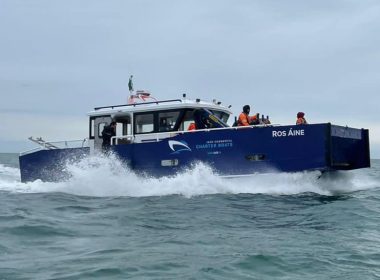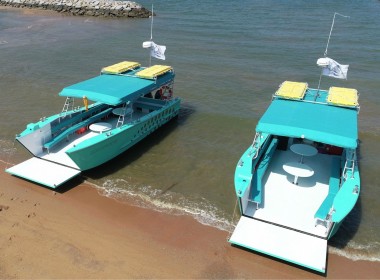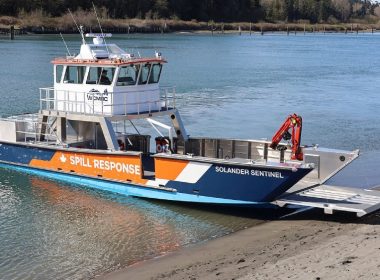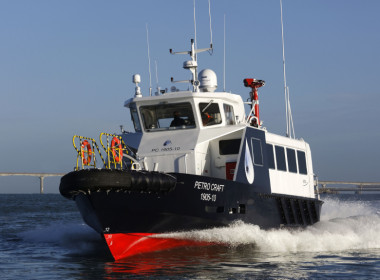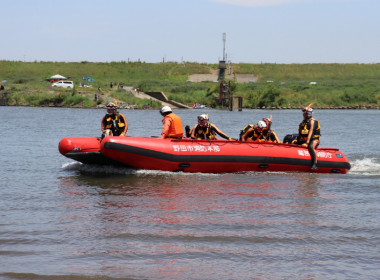AWARDS 2023 | Best Security Landing Craft – Island Guardian – Norman R. Wright and Sons

Best Security Landing Craft – Island Guardian – Norman R. Wright and Sons
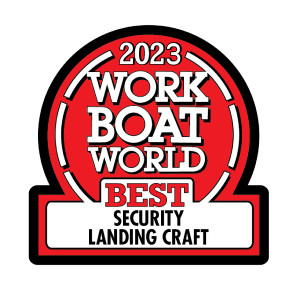
This fast, truly multi-purpose craft from Queensland’s renowned Norman R. Wright and Sons has a multitude of roles. It combines those of patrol boat, landing craft, Ro-Pax ferry, research vessel, general work boat and more for Australia’s Great Barrier Reef Joint Field Management Program.
An aluminium catamaran, it is fast, relatively economical, seaworthy and safe. It is an excellent illustration of the imagination and innovation for which Wrights is globally renowned.
“What makes the vessel special are its versatility and capability,” Tony Riek, Managing Director of Norman R. Wright and Sons (NRW), told Baird Maritime. “The specification called for high-speed (i.e., up to 25 knots) transits in rough seas carrying deck cargo of up to 7.5 tonnes, including vehicles such as four-wheel drives, trailers and excavators, plus up to 24 personnel, with the ability to land and deploy on remote beaches of varying gradients and in adverse conditions.”
Riek added that the specification also required amenities for up to seven people for 10 days at a time, two rigid inflatable boats (RIBs), two deck cranes, dive equipment, and a freezer room, making the vessel ideal for multi-day journeys and surveys of more remote sections of the Great Barrier Reef.
“A particular challenge in both design and build was the bi-folding ramp that provides the critical functionality of the vessel. The ramp had to be robust to withstand rough seas at high speeds and an integrated nacelle was incorporated to reduce pounding.
“The articulation and control required significant design work given the variety of landing sites (some with following seas) and vehicle types as well as requirements to support the release of marine life (e.g., turtles) of up to 600 kg from the end of the fully extended ramp at sea.”
Riek said the vessel design work was subcontracted, and the result was a design that was fabricated to the highest quality by aluminium contractor Lumark. Work on the ramp remained a team effort, and the lesson learned was to involve all parties – client, designer, subcontractors, and suppliers – to get a satisfactory result.
Riek remarked that the Australian workboat industry is being influenced by clients’ growing demand for versatility in the vessels they operate.
“I already made contact with workboat operators (particularly in the compliance/regulatory space) looking for smart designs that deliver greater versatility. In some cases, customers are looking to replace their larger assets with a number of smaller, highly capable vessels.”
Another trend Riek noticed relates to crewing, particularly the inability to recruit crews. One outcome of this is the trend to automation and uncrewed or “reduced crewed” vessels. In response to this, NRW is currently building an unmanned surface vessel (USV) for conducting monitoring activities on the Great Barrier Reef.
“We are also working with clients who are actively ‘raising the bar’ for workboats by improving amenity and fitout quality so as to attract crews to their organisations,” Riek told Baird Maritime. “Certainly, this sits well with our strategy of bringing a higher level of quality to the workboat industry.
Riek remarked that the greatest noticeable trend is a push to decarbonise fleets, though discussions with clients on this topic have been admittedly few.
“I have already discussed our strategy for electrification of passenger ferries, but for general workboats, the likely solutions are less clear. Our immediate strategy for addressing this problem is the same as it always has been – design and build with performance in mind.”
In Riek’s view, a good hull design based on rigorous process and testing, combined with the optimised use of lightweight materials and structures, lead to the consistent delivery of vessels with high efficiencies, sometimes up to 50 per cent better than like for like vessels, with little impact on project cost.
“These efficiencies lead to lower operating costs and lower emissions for the life of the vessel and should form the baseline prior to investigating/implementing any alternate powering strategies.”
For a list of the 2023 “Best Of” award winners, please click here.




